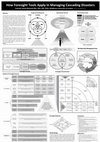Papers by Ardeshir Sayah
Futures studies have enormous effect to reduce the development gap between developing and develop... more Futures studies have enormous effect to reduce the development gap between developing and developed countries. But there are challenges in developing countries that deeply affect foresight activities and diminish its applicable usage. Although future oriented planning usually faces natural difficulties to properly assume all values and assumptions of all stakeholders, but in developing countries some key challenges affect the outputs of the foresight process severely. In this writing these challenges are categorized into four main groups. The first group of challenges refers to Foresight assumptions and context, the second is methodological aspects of foresight, next Foresight stakeholders and networking, and finally technological aspects of foresight and its related challenges.
Conference Presentations by Ardeshir Sayah

Institute for Risk and Disaster Reduction (IRDR), 9th Annual Conference on Cascading and Interconnected Risk, 19th June 2019, University College London (UCL), UK, London, 2019
Abstract
The human efforts to be prepared better for the future challenges of natural hazards go... more Abstract
The human efforts to be prepared better for the future challenges of natural hazards go back ages. There are several trends which suggest that mega-disasters occurring more frequently in the future. So, there is no way than improve preparedness in a diverse future-oriented manner.
One of the main applications of foresight in Disasters is avoiding systematic failures. In this research, the relations between ‘risk management’, ‘Foresight’, and ‘Natural Hazards” elaborated. On one hand, Foresight practices have recently grown in many disciplines and there is limited evidence of applying foresight in Disasters. On the other hand, variety of available Foresight tools are not commonly used in DRM; therefore, it is an opportunity to apply foresight as a new area of improving long-term insights and extend foresight application in managing disasters.
In this research, extensive methodological literature review in disaster risk management (DRM) and Foresight have done to introduce an emerging opportunity to shape the future. The model is validated by two rounds of Delphi, with the participation of 43 qualified experts. The generic model could be used widely, while the main source of data for validating the model is limited to the expert’s opinions in Iran.
An applicable foresight framework is provided within the context of DRM. The position of Foresight in DRM framework and cascading disasters has been proposed as well. The results of this study reveal that there are significant conceptual similarities and differences in these two fields.
The main value of this research is to clarify the relationship between the two interdisciplinary fields of Foresight and DRM. Also, a specific conceptual model is provided in which a novel matrix recommends to select proper foresight approach in DRR. Finally, a cumulative framework of foresight patterns that includes the new model is presented to be applied in DRM.







Uploads
Papers by Ardeshir Sayah
Conference Presentations by Ardeshir Sayah
The human efforts to be prepared better for the future challenges of natural hazards go back ages. There are several trends which suggest that mega-disasters occurring more frequently in the future. So, there is no way than improve preparedness in a diverse future-oriented manner.
One of the main applications of foresight in Disasters is avoiding systematic failures. In this research, the relations between ‘risk management’, ‘Foresight’, and ‘Natural Hazards” elaborated. On one hand, Foresight practices have recently grown in many disciplines and there is limited evidence of applying foresight in Disasters. On the other hand, variety of available Foresight tools are not commonly used in DRM; therefore, it is an opportunity to apply foresight as a new area of improving long-term insights and extend foresight application in managing disasters.
In this research, extensive methodological literature review in disaster risk management (DRM) and Foresight have done to introduce an emerging opportunity to shape the future. The model is validated by two rounds of Delphi, with the participation of 43 qualified experts. The generic model could be used widely, while the main source of data for validating the model is limited to the expert’s opinions in Iran.
An applicable foresight framework is provided within the context of DRM. The position of Foresight in DRM framework and cascading disasters has been proposed as well. The results of this study reveal that there are significant conceptual similarities and differences in these two fields.
The main value of this research is to clarify the relationship between the two interdisciplinary fields of Foresight and DRM. Also, a specific conceptual model is provided in which a novel matrix recommends to select proper foresight approach in DRR. Finally, a cumulative framework of foresight patterns that includes the new model is presented to be applied in DRM.
The human efforts to be prepared better for the future challenges of natural hazards go back ages. There are several trends which suggest that mega-disasters occurring more frequently in the future. So, there is no way than improve preparedness in a diverse future-oriented manner.
One of the main applications of foresight in Disasters is avoiding systematic failures. In this research, the relations between ‘risk management’, ‘Foresight’, and ‘Natural Hazards” elaborated. On one hand, Foresight practices have recently grown in many disciplines and there is limited evidence of applying foresight in Disasters. On the other hand, variety of available Foresight tools are not commonly used in DRM; therefore, it is an opportunity to apply foresight as a new area of improving long-term insights and extend foresight application in managing disasters.
In this research, extensive methodological literature review in disaster risk management (DRM) and Foresight have done to introduce an emerging opportunity to shape the future. The model is validated by two rounds of Delphi, with the participation of 43 qualified experts. The generic model could be used widely, while the main source of data for validating the model is limited to the expert’s opinions in Iran.
An applicable foresight framework is provided within the context of DRM. The position of Foresight in DRM framework and cascading disasters has been proposed as well. The results of this study reveal that there are significant conceptual similarities and differences in these two fields.
The main value of this research is to clarify the relationship between the two interdisciplinary fields of Foresight and DRM. Also, a specific conceptual model is provided in which a novel matrix recommends to select proper foresight approach in DRR. Finally, a cumulative framework of foresight patterns that includes the new model is presented to be applied in DRM.